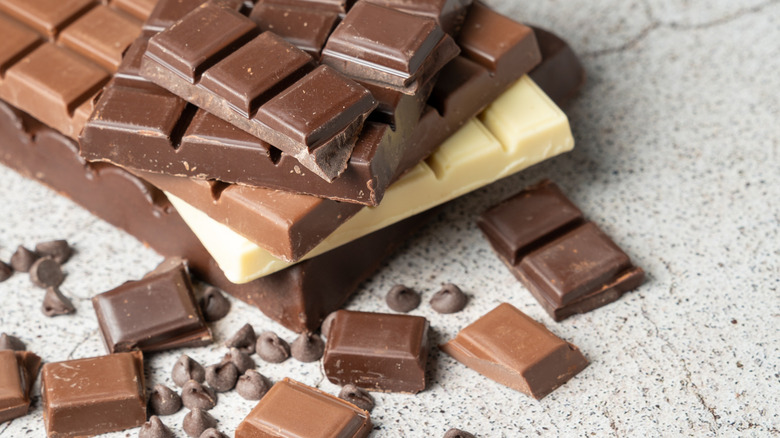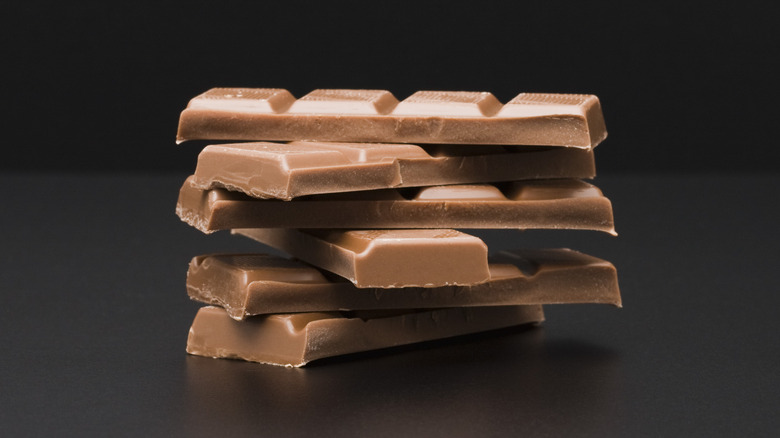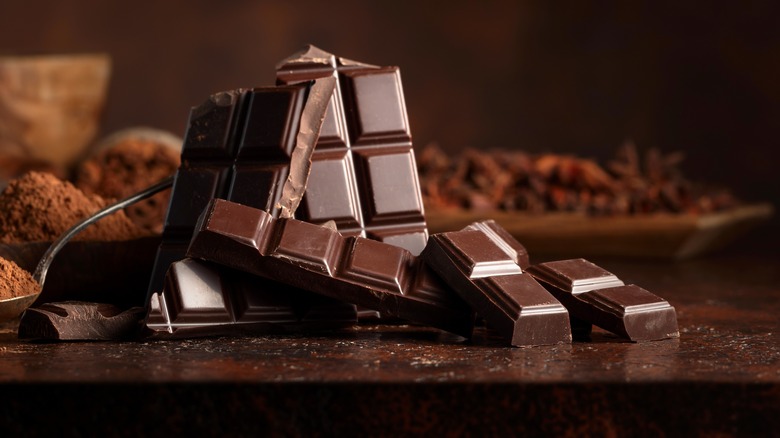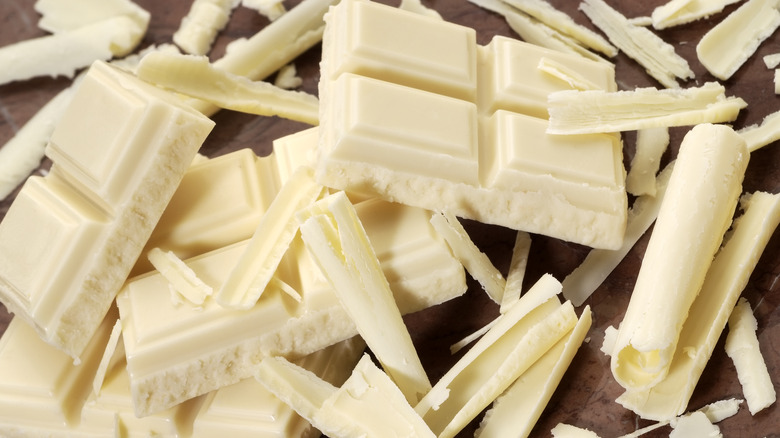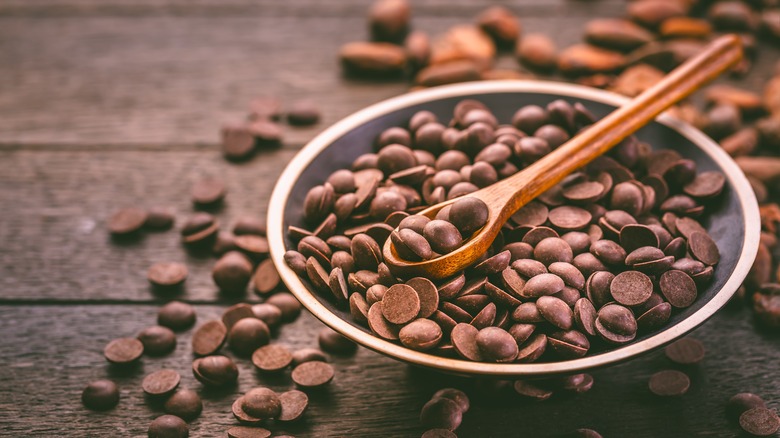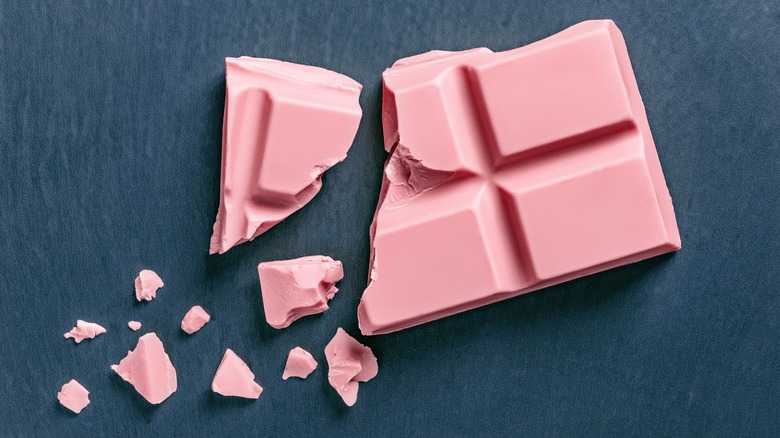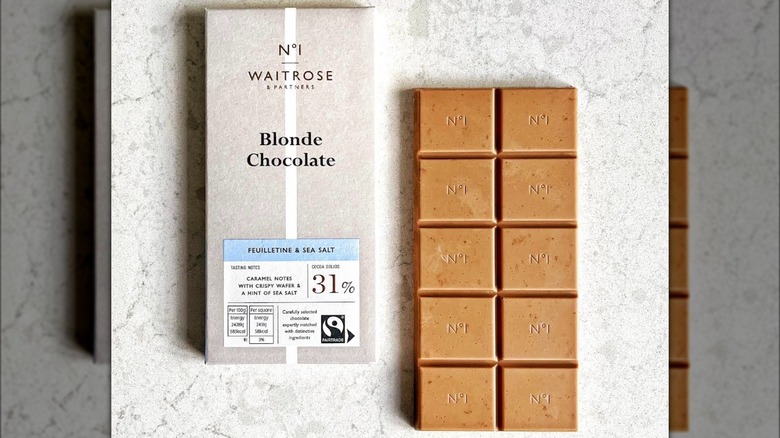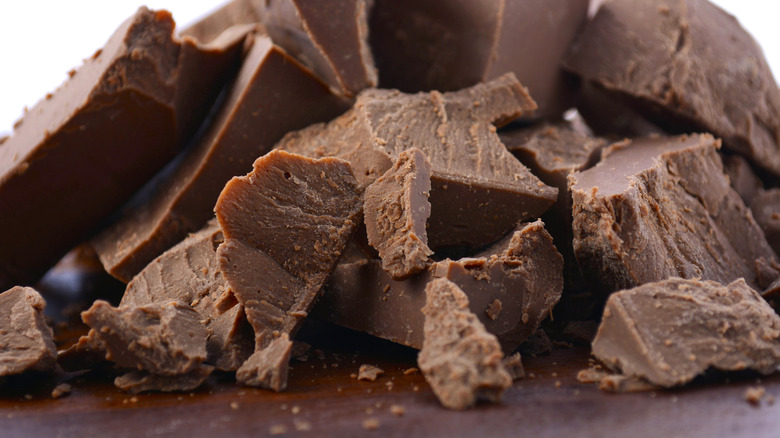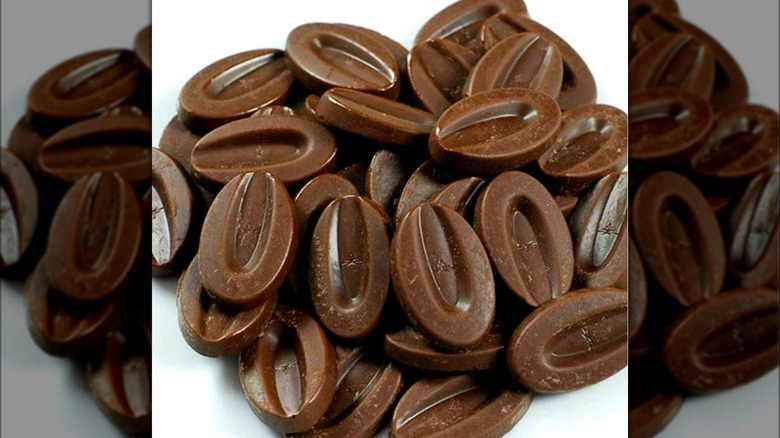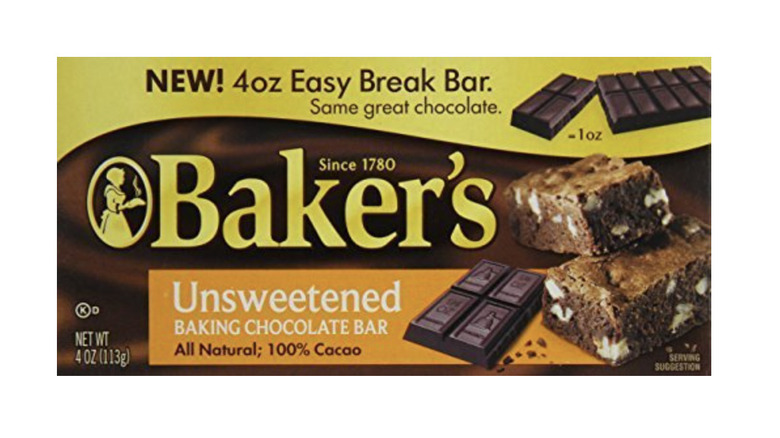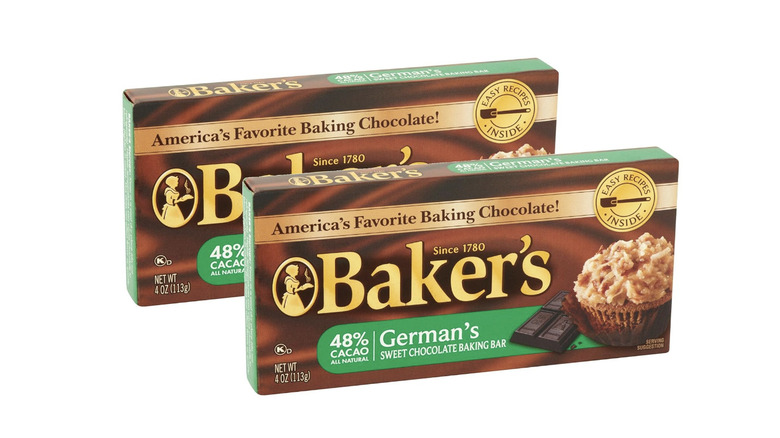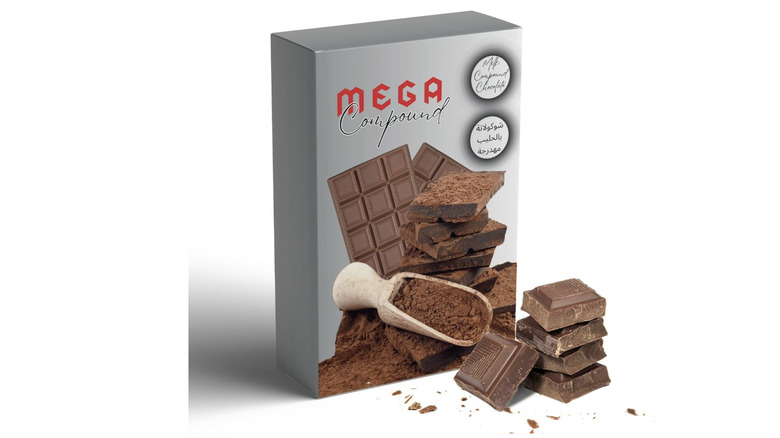Different Types Of Chocolate And How To Use Them
We may receive a commission on purchases made from links.
There's no denying that Americans have a sweet tooth, with chocolate rating high on many shopping lists. The U.S. is one of the world's top consumers of chocolate, with the average American enjoying 10 pounds of the confection annually. Made from roasted and ground cocoa beans, chocolate isn't just delicious but can also offer several health benefits. Eating between one and two ounces of chocolate with a high cocoa content a day can increase good cholesterol and decrease bad cholesterol, improve cardiovascular health, and boost energy levels.
Whether it's in the form of a classic bar or indulgent truffles, for many, the rich flavor and silky texture of high quality chocolate is hard to beat. However, while most of us are familiar with milk, dark, and white chocolate, the world of chocolate extends far beyond these three classic treats. From indulgent couverture chocolate to wallet-friendly compound chocolate, each type of chocolate is distinguished by its percentage of cocoa butter, ground cocoa, and additional ingredients such as milk, and sugar.
Keen to find out more about the lesser-known chocolate types? We're here to shed some light on all your chocolate options and how to incorporate them into your culinary repertoire.
Milk chocolate
There's nothing quite like the decadent flavor and the creamy texture of milk chocolate. In fact, around half of Americans favor milk chocolate above other types of the confection. The popular treat is made by mixing cocoa solids, cocoa butter, sugar, and milk. An emulsifier is also sometimes thrown into the mix to give the chocolate a smoother consistency. The FDA specifies that milk chocolate must be made with at least 10% chocolate liquor (mix of cocoa solids and cocoa butter) and 12% milk solids. The milk can come in different forms — such as regular milk, milk powder, or condensed milk — each adding a specific nuance to the taste of the final product.
Milk chocolate is perfect on its own. It's also great in fondues, where it's paired with a huge range of dippable treats like strawberries, marshmallows, and chunks of cake. Melted milk chocolate also makes a delicious topping for ice creams, waffles, and pancakes. Being ultra versatile, the confection can also be incorporated in baked goods, desserts, and drinks. For an indulgent snack, why not try making chocolate covered popcorn? To make the finger food, simply melt some milk chocolate, sprinkle it with sea salt, and pour the mixture over the popcorn.
Dark chocolate
When it comes to sweet goodies, dark chocolate ranks relatively closely behind milk chocolate, with 34% of over 5,000 American adults saying it's their favorite type of chocolate. Although made from similar core ingredients, dark chocolate isn't as sweet as its milk counterpart because it contains less sugar and more cocoa. While the FDA doesn't specify how much cocoa a product must contain to be classified as dark chocolate, it's generally accepted that this percentage ranges between 50% and 90% — the more cocoa, the more bitter the taste of the chocolate. Also, unlike milk chocolate, dark chocolate doesn't contain milk.
Dark chocolate is commonly regarded as healthier than other chocolate types due to its higher cocoa content and lower amounts of sugar. As such, if eaten in moderation, dark chocolate can be a satisfying and nutritious snack. That said, it's generally not recommended to consume more than one to two ounces of the confection a day, as it's also filled with calories. Just like milk chocolate, dark chocolate is great for baking, adding a robust flavor to cakes, cookies, and brownies. The indulgent confection can also be used to make recipes like salted dark chocolate granola bars and molten chocolate lava cakes.
White chocolate
White chocolate was first invented as a way to utilize cocoa butter, which is a byproduct of chocolate production. While recipes for white chocolate have been around since the 1870s, the product only gained popularity after Nestlé released the Milkybar in 1936.
Despite its name, white chocolate hasn't traditionally been classified as chocolate due to its lack of cocoa solids — the product is made with cocoa butter, sugar, and milk. In fact, up to 2002, the FDA classified white chocolate as a "confectionery coating." The regulations were updated that year, officially classifying white chocolate as chocolate as long as it satisfies a number of criteria. To be labeled white chocolate, a product must contain at least 20% cocoa butter, 14% milk solids, 3.5% milkfat, and no more than 55% sugar.
Sweet, creamy, and more subtle in taste than dark and milk chocolate, white chocolate can add richness to a variety of confections and desserts. For instance, the product can be utilized to make a white chocolate cake, where it can be both blended into the batter and used to make a rich buttercream frosting. The confection is also the shining star in three-ingredient white chocolate truffles, where it's combined with cream cheese and pumpkin seeds.
Semisweet chocolate and bittersweet chocolate
Semisweet chocolate and bittersweet chocolate fall somewhere between dark chocolate and milk chocolate in terms of flavor and sweetness level. The two main elements that differentiate semisweet chocolate and bittersweet chocolate are their cocoa and sugar content. While the exact proportions of ingredients in each type of chocolate aren't officially defined, it's generally agreed that semisweet chocolate should contain at least 35% cocoa solids and bittersweet chocolate between 50% and 80% cocoa solids. Semisweet chocolate also normally contains more sugar than bittersweet chocolate and is slightly lighter in color than its less sugary counterpart.
The two chocolate types have slightly different flavor and texture profiles. As its name suggests, semisweet chocolate is noticeably sweeter than bittersweet chocolate thanks to a higher sugar content and lower cocoa levels. It's also creamier than bittersweet chocolate due to a higher percentage of cocoa butter. On the flip side, bittersweet chocolate is more astringent in flavor and features a drier and crumblier texture.
Both semisweet chocolate and bittersweet chocolate are normally used in baking. In fact, they can usually be substituted for one another in recipes to suit different flavor preferences. For instance, a chocolate brownie recipe that calls for semisweet chocolate chips can be modified by using bittersweet chocolate, depending on how rich you want the final dessert to be.
Ruby chocolate
If you haven't heard of ruby chocolate, you're in for a colorful surprise. Invented in 2017 by a Swiss chocolate manufacturer, Barry Callebaut, the pink-hued treat isn't just visually striking but also delicious. In the words of Barry Callebaut, the chocolate is "neither bitter, milky, or sweet. It's rather a tension of fresh berry fruitiness and luscious smoothness." Since ruby chocolate melts just like any other chocolate type, it can be used to add a berry twist to traditional chocolate recipes.
So what's the secret behind this new, innovative type of chocolate? Luckily, it's not artificial coloring. Instead, the chocolate is made with special ruby cocoa beans sourced from Brazil, Ecuador, and the Ivory Coast — all countries with similar terroirs. While the exact content and production process behind the pink sweet are a closely guarded secret, we do know that ruby chocolate contains citric acid.
Barry Callebaut's CEO at the time of its release, Antoine de Saint-Affrique, described ruby chocolate in an interview with Bloomberg, saying, "It's natural, it's colorful, it's hedonistic, there's an indulgence aspect to it, but it keeps the authenticity of chocolate." With so much going for the product, it wasn't long before some of the world's top confectionery companies took notice, with Kit Kat, Magnum, and Häagen-Dazs promptly releasing their own ruby chocolate products.
Blonde chocolate
Not to be confused with white chocolate, blonde chocolate is slightly darker in color than its paler counterpart. While both chocolate types share a base of cocoa butter, sugar, and milk solids, it's the slow heating process that gives blonde chocolate its unique flavor and color. More specifically, it's this "caramelization" process that transforms white chocolate into a golden-hued confection with a rich toffee and butterscotch flavor.
Accidentally invented in 2004, blonde chocolate is a relatively new kid on the chocolate block. The sweet treat came to life when a pastry chef, Frédéric Bau, forgot he had left some white chocolate in a bain-marie. After several hours of roasting, the chocolate underwent the Maillard reaction — a biochemical process between the sugar and the amino acids in milk — which browned the ingredients, resulting in the creation of blonde chocolate.
Just like other chocolate varieties, blonde chocolate can be used to add flavor to baked goods or melted down to make ganache for truffles and pastries. All in all, blonde chocolate is a great alternative to white chocolate in recipes where a more robust flavor is preferred over the mild, subtly sweet taste of white chocolate.
Gianduja chocolate
The perfect choice for those with a sweet tooth who also enjoy the earthy taste of nuts, Gianduja chocolate gets its distinct flavor from finely ground hazelnuts. In fact, to be classified as such, Gianduja chocolate must contain at least 30% hazelnuts. Gianduja chocolate comes in milk or dark chocolate variants and is typically softer than standard chocolate due to the addition of nuts.
Gianduja chocolate was invented by Italian chocolatiers in the early 1800s, after the trade blockades imposed during the Napoleonic Wars made cocoa scarce and expensive. To make their limited cocoa supplies go further, many chocolatiers in Turin, the capital of Piedmont, began mixing it with local hazelnuts. This delicious chocolate and hazelnut blend was eventually named Gianduja, after a regional carnival character.
Aside from traditional chocolate bars, Gianduja chocolate is often sold as a Nutella-like spread or in individually-wrapped triangles called Gianduiotti. While the sweet, nutty flavor of Gianduja chocolate makes it a perfect addition to many dessert recipes, the sugary treat is also a favorite alongside a cup of coffee or a cheese and fruit platter.
Couverture chocolate
What sets couverture chocolate apart from other types of chocolate is its high cocoa butter content. In fact, the sweet is normally composed of at least 31% cocoa butter (sometimes this percentage is as high as 39%) and 35% cocoa solids. It's this high cocoa butter content that imparts couverture chocolate with a beautiful glossy finish and a satisfying snap when broken. Available in dark, milk, and white varieties, couverture chocolate is often considered high-end and tends to be more expensive than other types of chocolate.
Unlike most other chocolate options, couverture chocolate isn't generally suitable for baking or recipes that require chocolate to be added to batter or dough, as it can yield inconsistent results. Instead, it's commonly used in confections such as truffles, dipped fruits, and glossy chocolate decorations. This is because the high percentage of cocoa butter in couverture chocolate means that it melts both quickly and evenly, resulting in a smooth texture when it sets.
Baking chocolate
Also sometimes called unsweetened chocolate or bitter chocolate, baking chocolate is the purest form of the sweet product. Made from 100% ground cocoa beans without any fillers like sugar or milk, baking chocolate isn't meant to be eaten on its own. Intensely bitter and bold in flavor, baking chocolate is usually used as a base in recipes rather than for snacking. As such, the product sometimes comes in chips, which makes it easier to melt or incorporate into doughs and batters.
Due to its basic, sugar-free nature, baking chocolate gives bakers more control over the flavor and texture of baked goods. This is because chocolate without added sugar is more difficult to burn than chocolate that contains a lot of sugar. As such, baking chocolate isn't going to caramelize and burn when heated, allowing bakers to create their desired dish without the risk of unwanted bitterness. That said, many recipes that call for baking chocolate also require some sugar to offset the bitterness of the chocolate. For instance, a recipe for gooey brownies calls for baking chocolate, brown sugar, as well as other ingredients like butter, eggs, flour, and vanilla extract.
German's sweet chocolate
Despite its name, German's sweet chocolate wasn't created in Germany, but in the U.S. The chocolate bears the name of its inventor, Samuel German, who came up with the confection in 1852. German sold the recipe for his chocolate to the Baker's Chocolate Company for $1,000, after developing it while working there as a coachman. So what differentiated German's sweet chocolate from other similar products at the time? The key difference was that the confectionery was lower in cocoa butter and higher in sugar.
Initially advertised as "good to eat and good to drink" and "palatable, nutritious, and healthful," today German's sweet chocolate is most commonly used as an ingredient in German chocolate cake. While the exact origins of the cake are unclear, the first recipe for the dessert appeared in the Dallas newspaper, "The Irving News Record," in 1956. The recipe calls for Crisco and a packet of German's Sweet Chocolate. Meanwhile, the icing is made with coconut, pecans, egg yolks, butter, sugar, and evaporated milk. German chocolate cake is enjoyed to this day, and while some recipes still call for German's sweet chocolate, others replace the product with more accessible types of chocolate.
Compound chocolate
Compound chocolate is the underdog of the chocolate family. Also sometimes called candy coating and confectionery coating, compound chocolate is made with vegetable oils like palm oil, coconut oil, or soy oil rather than cocoa butter. Aside from vegetable oil, the product also contains sugar, milk, emulsifiers, and cocoa powder. Since vegetable fats have a higher melting point than cocoa butter, compound chocolate is unlikely to give you the melt-in-the-mouth feeling of real chocolate. In addition, compound chocolate is usually sweeter than regular chocolate and lacks the subtle flavor complexities of authentic chocolate.
Commonly used for commercial purposes, compound chocolate is cheaper than other types of chocolate and doesn't require tempering, which means that it's easier to work with. With superior melting and molding characteristics, compound chocolate is frequently used for coating candies, cakes, and other confections in industrial settings. Additionally, the sweet keeps relatively well due to its higher melting point than regular chocolate, which makes it easier to handle and distribute. If you choose to work with compound chocolate in your kitchen, one word of advice: never mix it with real chocolate, as cocoa butter and vegetable oils don't mix well together and can make the dessert discolored and generally unappetizing.
